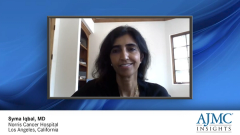
Quality of Life Impacted by Treatment of ESCC and Upper GI Cancer
Syma Iqbal, MD, discusses how ESCC and GI cancer treatment pathways may have a myriad of effects on patient quality of life.
Episodes in this series

Syma Iqbal, MD: As we’ve incorporated immunotherapy into frontline treatment, there have been evaluations of quality of life. It appears that the toxicities associated with immunotherapy are manageable and that there’s even benefit to quality of life with the incorporation of immunotherapy for these patients. There isn’t a negative impact in the context of the quality of life. Even though we’re adding another therapeutic agent, the agent itself is well tolerated and the toxicities are manageable.
As patients are treated with metastatic disease, we assess response to therapy generally every 4 cycles. Every few months, they’re getting restaged, usually by being rescanned with CTs of chest, abdomen, and pelvis, depending on where the bulk of their disease is. If patients are restaged and their disease demonstrates a 20% or greater increase of their tumor, adding all the sites of metastases, then that’s considered progressive disease. If there’s less than a 20% increase in the size of the lesions, then those patients are considered to have stable disease. If there’s a 30% decrease, that’s considered a partial response. That’s how we assess these patients. They continue on therapy as long as they’re responding and as long as they’re tolerating it. Stable disease or a response is considered a success in treatment.
Many times, patients start developing toxicity related to the platinum therapies. They start developing dose-limiting neuropathy. If that’s the case, we usually drop the platinum but continue with the 5-FU [5-fluorouracil]–based regimen in addition to the immunotherapy. That’s a pretty standard approach. We continue chemotherapy plus immunotherapy as long as it’s working and as long as patients are tolerating it. We determine whether it’s working based on assessing the CT scans and looking at the cumulative measurements of the tumor to determine their response. If patients have progressive disease, then they’ll move to the next line of treatment based on their performance status.
Transcript edited for clarity.
Newsletter
Stay ahead of policy, cost, and value—subscribe to AJMC for expert insights at the intersection of clinical care and health economics.










































